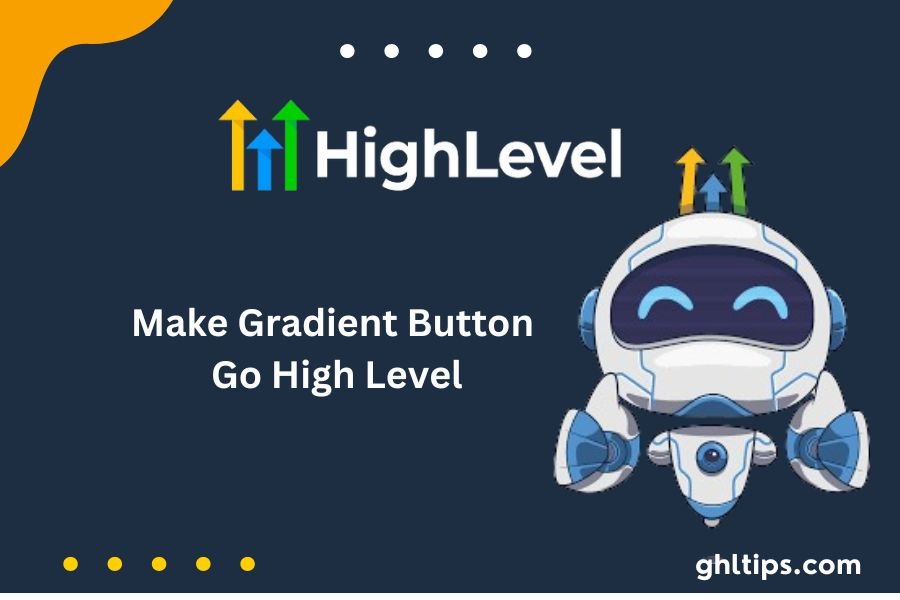Creating Magnetic Gradient Button Go High Level A way to build an engaging and well-designed website is to use gradient buttons. These buttons are helpful because they draw the user’s attention to critical areas of your site.
These buttons are different as they blend two or more colours, create a bit of depth, and make them stand out from flat button designs. This article will make Gradient Button Go High Level, increasing your audience’s engagement on your website and improving the overall look of your website.
Making Gradient Button Go High Level and using them takes up a lot of practice and skill for any developer, but this guide will focus on not just designing the gradient buttons but also the best practices to implement what you have created.
Table of Contents
What Are Gradient Controls?
A gradient button can be defined as a lightweight control that has a smooth transition from one colour to another or includes more than one colour. This design appropriately plays up depth to the buttons so that they stand out loudly against an essential background. With these kinds of buttons, you improve the outlook of a screen, but more importantly, you make customers sign up for things like newsletters or make purchases.
Why gradient buttons?
Their use guarantees improved engagement rates. Their tones are eye-catching, and users are encouraged to click on them. In addition, Gradient Button Go High Level can fit in your branding colour, making the website look like one unit. Therefore, placing gradient buttons on the webpage helps the user interface be more vibrant.
Guidelines for Creating Your Gradient Button
Selection of Palette: When bringing gradient buttons to the next level, the first step is choosing the right colour palette. Every palette has emotions that might affect a user’s actions. For instance, Coral (#ff7e5f) and Light Peach (#feb47b) give a clean and welcoming feel. When selecting colours, keep the following aspects in mind:
Complementary Colors: These colours appear on opposite sides of the colour wheel. This contrast will brighten your buttons significantly.
Analogous Colors: These colours appear adjacent to each other on the colour wheel, resulting in a smoother transition and a pleasing appearance.
Employing CSS for Gradient Start Buttons
Once the colours have been selected, the next step is to apply them to CSS. You can follow these simple instructions to create a Gradient Button Go High Level:
Give the button a class name: Give your button a class name so the styles are organized as best as possible; an example would be global__custom-bin.
Incorporating the Gradient Utilize the specific CSS code for seamless incorporation of gradients:
CSS: This code applies a smoother Gradient Button Go High Level Blend transition and includes a hover effect that encourages user interaction. However, ensure that you alter the gradient colours to suit your website.
For Featuring Implementation
Here Are Some Suggestions
Size and Shape Considerations
Keep in mind that applying gradient buttons raises the level, so when considering your buttons, try to size and shape them accordingly. After all, studies show that the buttons need to be at least 10 mm by 10 mm when used on mobile devices, as that is the average fingertip size. Of course, your buttons must also fit the shape of your overall design, whether rectangular or circular.
Placement on Your Website
The positioning of your gradient buttons is one of the most important things to note if you want your users to engage with your site more. Put them where people may want to click, like call-to-action areas. The position can significantly improve user comprehension and conversion rates if used wisely.
Ensuring Accessibility
Accessibility is one of the open puzzles while designing a website. Accessibility provisions ensure that even users with disabilities can access the information on the website. Make sure that your gradient buttons are compliant with accessibility standards, for example, WCAG AAA compliance, which includes the proper colour contrast over the background for the buttons and the visualization of different interactive states, including hover and pressed buttons.
Different Styles of a Gradient Button
Gradient Button Go High Level are creative to be at a high level in the usability spectrum. Here are some of the styles of gradient buttons:
Flat Gradients: Flat buttons do not have any rounded corners, and their colour gradient is smooth.
Three-dimensional Gradients: More than two colour gradients and a little depth give the button a more tactile feel.
Animation Gradient Gradient Buttons: The most widely used buttons are animated. For example, you can have a green button that turns red when hovered or change shape and gradually switch from one color to another.
How To Make Gradients Pop
CSS Gradient Creation
CSS is an effective tool for making Gradient Button Go High Level stand out on the interface. For example, the following code creates a gradient that transitions from pink to periwinkle.
Sometimes, the colour or even the gradient type fails to make your button visually appealing, which is where experimentation comes into play.
Gradients In Design Software
Using software to visually design the gradients helps by preventing time-wasting while writing code. This lets you see how different colours would work together before implementation.
How To Enhance The Visibility Of The Gradient Buttons
To make your Gradient Button Go High Level aesthetically pleasing and useful, try adding highlights and shadows. This will undoubtedly provide an element of three-dimensionality to your buttons, making them more clickable.
Conclusion: Gradient Button Go High Level
In short, putting Gradient Button Go High Level on higher levels is an easy technique to upgrade your website’s general view and usability. When you combine the correct colours, apply the CSS styling, and adopt good n practices, y practices will significantly increase the amount of user interaction your buttons get.
Don’t forget to consider inclusivity and play around with styles because different designs will suit your brand best. Following these guidelines, gradient buttons are just around the corner, bringing forth fantastic gradient buttons to help you enhance your web presence.
FAQs: Gradient Button Go High Level
What Are The Attributes Of Gradient Buttons, And How Do They Work?
These buttons’ design blends two or more colors, encouraging users to pay closer attention to their use.
How Do I Pick The Colours For Gradient Buttons?
You could use opposite colours to create a more exciting contrast or use colours that sit next to each other for a more soothing effect. Think about how you want people to feel when they see your selected colours.
What Is The Minimum Size For Buttons On Mobile Devices?
Button sizes should be at least 10 mm by 10 mm to fit comfortably in most thumbs, particularly in mobile devices, to ensure ease of use.
How Can I Ensure My Gradient Buttons Are Accessible?
To meet accessibility criteria, for instance, buttons and background colours should be strongly differentiated by hue, and interactive states such as hover and pressed states should be set up.
Can I Animate My Gradient Buttons?
You can animate your gradient buttons with CSS by changing colour or form when the mouse shifts over them to make them look more appealing.







